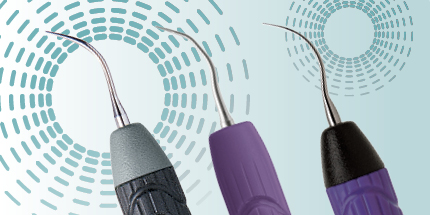Ultrasonic Insights - Fourteenth Edition
Ultrasonic Insert Options, Part II Light to Moderate Deposits
Slim Diameter Inserts
Removal of light to moderate deposits often requires an approach different from heavy deposits when selecting an ultrasonic insert for power scaling. A patient presenting with light to moderate deposit can be a candidate for treatment with slimmer diameter inserts. And, for patients with heavy deposits who are initially treated with robust inserts such as Hu-Friedy’s #10, #1000 or Beavertail, the benefits of power scaling can then be extended by switching to slimmer diameter inserts for the removal of the remaining light to moderate deposit.
Power Scaling: Light to Moderate Deposits
The Science—made simple
A physics principle considered when designing ultrasonic inserts is mass * acceleration = force. Less force is generally required for light to moderate deposit removal than is needed for heavier deposits. Thus, a slimmer diameter insert tip (mass) that is set to the same power setting (acceleration) as a wider insert will produce less force, making it efficient and effective for removal of light to moderate calculus while advancing patient comfort.
The Clinical Significance
Since more robust inserts produce greater force it can be asked: why not use a wide diameter inserts for all calculus removal? Wider diameter inserts, while very effective for removal of heavy debris, may exert more force than necessary for lighter deposit removal. Also, light/moderate deposits, while frequently located supragingivally, are also often present in subgingival and interproximal areas where access can be more challenging. Slimmer diameter inserts can allow for less tissue distension and for more precision scaling of intricate areas such as furcations, pockets, root concavities and areas under contacts. Since slimmer diameter inserts are designed for supra and subgingival use, they are ideal removal of light to moderate deposits.

Which inserts are designed for general removal of light to moderate calculus?
#100 Thin - Long thin shank extending to a thin, tapered tip. Round cross section. Thin shank allows effective subgingival and interproximal access. Ideal for periodontal maintenance and localized periodontal defects.
XT Triple Bend - Triple bend shank extending to a thin, beveled edge tip allows concentrated energy at corners for enhanced stain and calculus removal. Triple bend shank gives increased access around line angles and interproximally.
XT - Long, ultra-thin shank tapers to a very thin tip. Ideal for site specific areas including narrow, deep pockets, furcations, developmental concavities and tight areas between teeth.
While these inserts for light to moderate debris removal can be used on power settings from low to medium, it is recommended that the lowest effective power setting be used. And…just like hand scalers, ultrasonic inserts wear with use. Worn insert tips can significantly diminish scaling efficiency. Call 1-800-Hu-Friedy to request the INSERT WEAR GUIDE.

